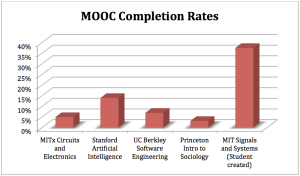New Year, New Learning from MOOCs
 Massively Open Online Courses (MOOCs) have been around the higher-ed space for years in various forms, but this year, MOOC is the big buzzword. Many major universities are jumping on the MOOC bandwagon, and are seeing people from across the globe flock to their open courses. As a recent NY Times article stated, “The shimmery hope is that free courses can bring the best education in the world to the most remote corners of the planet… (Pappano)”
Massively Open Online Courses (MOOCs) have been around the higher-ed space for years in various forms, but this year, MOOC is the big buzzword. Many major universities are jumping on the MOOC bandwagon, and are seeing people from across the globe flock to their open courses. As a recent NY Times article stated, “The shimmery hope is that free courses can bring the best education in the world to the most remote corners of the planet… (Pappano)”
For those of you caught a little off-guard by this concept, a MOOC is an online course that is a mashup of education and social networking. Taught by seasoned professors from prestigious universities, MOOCs offer online course content, social support of learning by peers, homework, and even exams, all for free. You don’t even have to enroll in the university! The catch? There is no course credit at the end of the road.
Why would universities go down this road? They see the potential to make large amounts of money on services wrapped around the course offering. Because the barriers to entry into a college-level course are so low, hundreds of thousands of students are signing up for these individual courses. If the university can convert just 10 percent of that to a profit-based enrollment, dollar signs light up.
For-profit companies and some universities are experimenting with this model. Coursera, one of the main for-profit companies offering MOOCS in partnership with major universities, recently announced Coursera Career Services, a business model to generate profit from matching companies with students (Jones-Bey). In 2013, the University of Wisconsin is rolling out a unique competency-based version of their existing programs called Wisconsin Flexible Option that will offer university credits based on passing assessments, not participating in a class. “Adult, non-traditional students will have the option to test out of the material they know or can learn from other sources, like MOOCs… flexibility comes from giving students many ways to successfully prepare for these assessments (Rovy Branon).”
Challenges
There is an inherent problem with the “Massive” part of a MOOC. As we have found at Florida Virtual School (FLVS), getting to know your students is a critical part of teaching online, and a reasonable course load ensures this occurs. Even with grad students helping to grade papers, academic integrity is an issue for MOOCs. In fact, Udacity, another for-profit MOOC company, requires proctored final exams if the students want a certificate of completion. As we learned with Kindergarten-12 online work, course design is incredibly critical the larger the enrollment, and MOOC courses need to grow in this area.
Another problem that most online programs struggle with is course completion rates. MOOCs suffer greatly from a very high dropout rate. “Online” often means an invitation for students of all ages to check out a course risk free, and the motivation of paying for a credit is missing from this model. MOOCs boast about a 10 percent completion rate (Carey), which is pretty abysmal. Some of the more seasoned universities are improving upon these statistics by starting to figure out how to make MOOCs work.
Data from (Watters), (Pappano) (Meyer) (Lewin) and (Watters)
Kindergarten-12 Learning
What can Kindergarten-12 online education learn from the MOOC model? In many ways, Kindergarten-12 is very similar to this model already – we have our content online accessible at any time, we have collaboration and a teacher, and we allow a risk-free period to try the course. When we look at what is working in the MOOC world, there are a few lessons for us.
- Peer Review and grading works. In a Princeton MOOC on Introduction to Sociology, the peer ratings on the exam were impressively correlated to the professor scores (Lewin).
- Short, Khan-like lessons make for happy students. Chunking content into small bites allows users to digest difficult information without a teacher in the room.
- Students lean on each other. Many MOOCs require students to form groups at the start of a course so they have a support structure amid the masses.
- Students create great experiences. A high school student used MIT Signals and Systems content, added student-created tutorials and experiences, and saw a 38 percent completion rate. (Watters)
I don’t think we will see MOOCs as the basis of our education system anytime soon; the inherent problems are very risky. However, this grand experiment in higher-ed will give us much to watch and learn from as improvements are made to serve the masses. Perhaps a small leap into professional development offerings in a MOOC format is a first step for our Kindergarten-12 world, since we need to learn about this phenomenon to learn about learning.
Post by Jennifer Whiting, Former Chief Technology Innovation Officer
Sources:- Carey, Kevin. The MOOC-Led Meritocracy. The Chronicle of Higher Education. Aug. 23, 2012.Jones-Bey, Lal. Coursera and your career. http://blog.coursera.org/post/37200369286/coursera-and-your-career
- Lewin, Tamar. College of Future Could Be Come One, Come All.http://www.nytimes.com/2012/11/20/education/colleges-turn-to-crowd-sourcing-courses.html?pagewanted=1&smid=pl-share
- Meyer, Robinson. What It’s Like to Teach a MOOC (and What the Heck’s a MOOC?). http://www.theatlantic.com/technology/archive/2012/07/what-its-like-to-teach-a-mooc-and-what-the-hecks-a-mooc/260000/
- Pappano, Laura. The Year of the MOOC. NY Times, Published: Nov. 2, 2012.
- Watters, Audrey. 6.003z: A Learner-Created MOOC Spins Out of MITx. Aug. 14, 2012. http://ecampus.wisconsin.edu/online-degree-programs/flex-option.aspx


Excellent points Jennifer! Ultimately, I think the concept, at least in higher education, will be driven by the economy. While the rising costs of higher education would seem to make MOOCS a sure winner, I say not so fast. I believe there are two determining factors which will ultimately determine long term success;
Parents – the majority of parents seem to approach traditional higher education like a birth right these days. “Regardless of financial or intellectual capability, don’t take my child’s right to a traditional education away”. If spending or borrowing federally backed money to invest hundreds of thousands of dollars for their kids to stand in the unemployment line without the proper skills, aligned to real economic development initiatives continues to be a birth right – there will be no real demand for MOCCS programs
Employers – if the skills acquired through MOCCS are not valued by employers and don’t lead to jobs, the concept may not die but it is more likely going to have to target continuing education. Many universities are moving in this direction but until we have employment data, the jury is still out on whether or not this is a strategic move for education or as you say, dollar signs are just lighting up.
Solve these two issues and long term transformation is on the way!
Great piece, thanks
Brian
Hi Brian! You make some great points here. It is going to be interesting to watch some of the universities that are really pushing this model. I suspect that costs are going to stay much the same – those “services” around free courses are not going to be cheap!
I do like the idea of MOOCS as continuing education. Certificates are a natural end point for a MOOC experience, and those that produce knowledge worthy of job improvement will rise to the top to be offered again.
Thanks for your response!
Thank you for the thought-provoking piece on the potential and reality of MOOCs, Jennifer! I recently participated in a MOOC as a student, along with a cohort of other colleagues. I was so excited at the possibility of interacting with leading scholars and looked forward to having great dialogue with my peers about trends and issues. Sadly, I found the MOOC to be missing a critical element for student success- an involved, engaged teacher.
MOOCS may serve as a creative commons where innovations can be shared and collaborations begun, or where lectures can be distributed for the benefit of the greater good. MOOCs can be large operations with thousands of participants who have something to say. But as a learning experience, the MOOC still requires personal feedback, facilitation of effective conversations, encouragement, and even fact checking. MOOCS could benefit from some of the same guidelines used to create and teach online courses. So while we celebrate the potential that MOOCs bring, let’s also raise the bar for quality too!
Hi Anne! Thanks for your insightful comments. We sure have learned at FLVS that the involved teacher is key to success. Is it possible for adult learners to supplant that in a MOOC as a peer community? Maybe, if it is set up right by the instructor. I think a learning network and appropriate infrastructure to support that will be critical to making that happen.